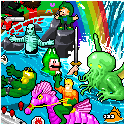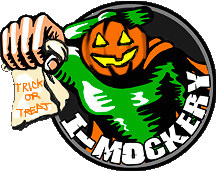Weeklies
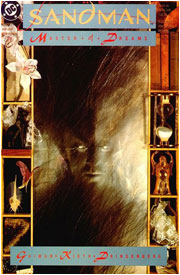
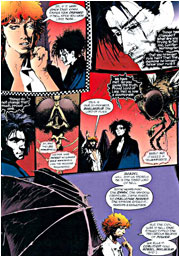
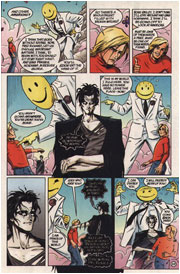
Comic: "The Sandman"
Published by: DC Comics
Written by: Neil Gaiman
Artist: Various
Reviewer: Protoclown
Posted: 11/9/2008
Plot: I can't put it any more succinctly than Neil Gaiman himself has phrased it: "The King of Dreams learns that he must change or die, and makes his choice."
Review: Watchmen and The Dark Knight Returns are the two most important comic series of the 1980s, and I don't think there's a single comic geek out there who would dispute that claim. Likewise, The Sandman is without a doubt the most important comic book of the 1990s. Being Vertigo's flagship launch title, if it had never existed, then it's very likely that books like Preacher, Fables, The Books of Magic, Crossing Midnight and certainly Lucifer would not exist either. Not only did it almost single-handedly (along with Hellblazer) pave the way for DC's ever popular mature readers imprint, but this comic book has almost certainly brought more non-comic readers into the fold than any other comic book ever has.
The popularity of Sandman spread by word of mouth, by people looking over their friend's shoulders and saying "What is that, and where can I find it?" It drew people into comic shops at a time when you couldn't just find any old trade paperback at your local Barnes & Noble--and once inside, who knows what other books might have caught these readers eyes, what else they might have plunked their money down on? At a time when foil covers, big-breasted, big-biceped heroes, and flashy art were all the rage, Neil Gaiman's adult fantasy/horror series was a breath of fresh air, making the comic industry start to care about the writers again, a trend that has thankfully continued to this day.
The first volume, Preludes and Nocturnes reads a bit clunky and awkward at times, the art is ugly in places, and the coloring is atrocious (thankfully all fixed in the more than worthwhile "Absolute Sandman" collections)--it's a product of the late 80s, early 90s through and through--but by the time you get to the rather disturbing story "24 Hours", the book's potential begins to reveal itself. And by the time I got to the last issue in the volume, "The Sound of Her Wings", introducing Dream's plucky sister Death, I was hooked upon learning that Dream wasn't alone in the universe--he had a whole dysfunctional family called the Endless, and I was dying to meet them. And meet them you will, if you give the book a chance and get to the much more fantastic second volume, The Doll's House.
From that point the series started to drop its horror slant, branching more into the realm of fantasy. And that's what Neil Gaiman does best: making the impossible seem real, as if these magnificent people and creatures have been around all this time but have gone about unnoticed by mundane man. We see characters from many different mythologies (including comics) interacting together, and it all seems as perfectly natural as it is delightful.
The highlights of the series are Season of Mists, where Dream is given the key to Hell by a retiring Lucifer; my personal favorite Brief Lives, where Dream and his youngest sister Delerium set out on a quest to find their long lost brother; and what is probably the best in the series, The Kindly Ones, which brings Dream's story to its climactic end. Scattered throughout the series are plenty of one-shot tales, many in which Dream plays only a tangential part, or in some cases, no part at all. Above all else, The Sandman is a story about the nature of stories and why they are so important to humankind.
One of the best things about Sandman is that Gaiman employed different artists on different story arcs, so not only do they each have a different feel in terms of theme and tone, but the style of the artwork varies from one story arc to the next, giving each one a unique character. And apparently there was no shortage of artists out there wanting to work on this book, because if there was one book that everybody had their eyes on in the 90s, this was it. You'll no doubt enjoy some of the artists better than others, but if you come across one you can't stand, just know that it'll only be a matter of time before they switch again. I feel the lettering (yes, the lettering!) in this book is worthy of special recognition as well. Todd Klein lettered every issue of The Sandman, and he gave dozens of different characters their own unique font to help give each of them a distinct voice. I don't know of a better letterer in the industry, and this is the best example of the scope and detail of his work. Another thing I have to mention is Dave McKean's brilliant covers. He had to fight to convince Vertigo Editor Karen Berger that they didn't have to have the main character featured on the cover of every issue--that sort of thing simply wasn't done back in 1989.
The Sandman could have gone on for a lot longer than it did, but Gaiman wisely decided to end the epic series at the height of its popularity, leaving the fans wanting more, but never disappointing by milking the story for more money and causing a downturn in quality. This is one series that never jumped the shark, and thankfully most Vertigo books have followed suit, all requiring some kind of definite ending (the one exception to the rule being Hellblazer) to even see print. In fact, though the Endless have occasionally appeared in other DC books since the end of Sandman, every appearance is approved by Gaiman, so that the power and quality of these characters isn't ruined by oversaturation (see Wolverine).
Some aspects of this book may not seem so special now, but you have to take into account that back when this book was coming out, there was nothing like it on the shelf. Many of the books you enjoy today owe a lot to Sandman, as does the comic industry as a whole, because it took the work started by Watchmen and Dark Knight and amplified it, finally giving comics the respect they deserved as an artistic medium.
If you're into comics and you've never read The Sandman, what are you waiting for? Every comic fan worth their salt has read this one, because it's not only one of the best comic books you'll ever read, but it's a crucial piece of comic book history.
Overall rating: ![]()
![]()
![]()
![]()
![]()
(Scored on a 0.5 - 5 pickles rating: 0.5 being the worst and 5 being the best)
Reader Comments
There was a spinoff (The Dreaming) which had some very dodgy moments, but a few good ones as well. It detailed the lesser characters of the Dreaming - Mervyn, Cain and Abel, the Thessalian, etc.
Let's all pray they never try to make a film of Sandman, because it would have to be at least a trilogy, and I trust no one but Del Toro or maybe Peter Jackson to do it any sort of justice. What say you?
i am really enjoying his short stories, too. i agree that nobody should try to do a movie on the Sandman, adn i kinda doubt they will. but if they do, i hope they choose a soundtrack from bands like Joy Division, the Cure, the Smiths, Sisters of Mercy, This Mortal Coil, etc... otherwise it would SuXoR!!!
Follow us on:
![]()
![]()
![]()
![]()
Want Your Ad Here?
Send us an email!


